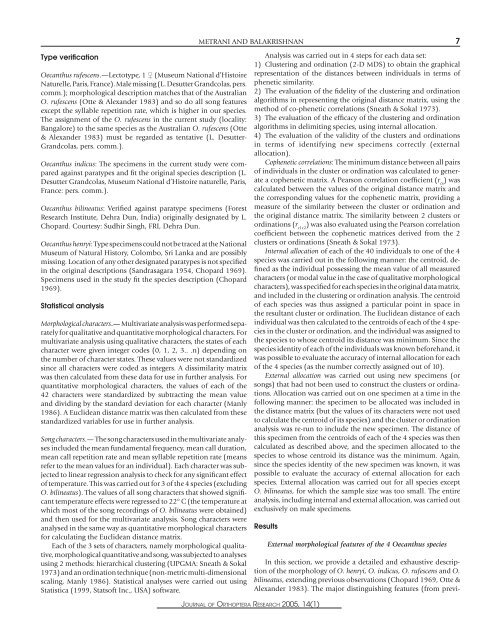The utility of song and morphological characters in delineating ...
The utility of song and morphological characters in delineating ...
The utility of song and morphological characters in delineating ...
Create successful ePaper yourself
Turn your PDF publications into a flip-book with our unique Google optimized e-Paper software.
Type verificationOecanthus rufescens.—Lectotype, 1 ♀ (Museum National d’HistoireNaturelle, Paris, France). Male miss<strong>in</strong>g (L. Desutter Gr<strong>and</strong>colas, pers.comm.); <strong>morphological</strong> description matches that <strong>of</strong> the AustralianO. rufescens (Otte & Alex<strong>and</strong>er 1983) <strong>and</strong> so do all <strong>song</strong> featuresexcept the syllable repetition rate, which is higher <strong>in</strong> our species.<strong>The</strong> assignment <strong>of</strong> the O. rufescens <strong>in</strong> the current study (locality:Bangalore) to the same species as the Australian O. rufescens (Otte& Alex<strong>and</strong>er 1983) must be regarded as tentative (L. Desutter-Gr<strong>and</strong>colas, pers. comm.).Oecanthus <strong>in</strong>dicus: <strong>The</strong> specimens <strong>in</strong> the current study were comparedaga<strong>in</strong>st paratypes <strong>and</strong> fit the orig<strong>in</strong>al species description (L.Desutter Gr<strong>and</strong>colas, Museum National d’Histoire naturelle, Paris,France: pers. comm.).Oecanthus bil<strong>in</strong>eatus: Verified aga<strong>in</strong>st paratype specimens (ForestResearch Institute, Dehra Dun, India) orig<strong>in</strong>ally designated by L.Chopard. Courtesy: Sudhir S<strong>in</strong>gh, FRI, Dehra Dun.Oecanthus henryi: Type specimens could not be traced at the NationalMuseum <strong>of</strong> Natural History, Colombo, Sri Lanka <strong>and</strong> are possiblymiss<strong>in</strong>g. Location <strong>of</strong> any other designated paratypes is not specified<strong>in</strong> the orig<strong>in</strong>al descriptions (S<strong>and</strong>rasagara 1954, Chopard 1969).Specimens used <strong>in</strong> the study fit the species description (Chopard1969).Statistical analysisMorphological <strong>characters</strong>.— Multivariate analysis was performed separatelyfor qualitative <strong>and</strong> quantitative <strong>morphological</strong> <strong>characters</strong>. Formultivariate analysis us<strong>in</strong>g qualitative <strong>characters</strong>, the states <strong>of</strong> eachcharacter were given <strong>in</strong>teger codes (0, 1, 2, 3.. .n) depend<strong>in</strong>g onthe number <strong>of</strong> character states. <strong>The</strong>se values were not st<strong>and</strong>ardizeds<strong>in</strong>ce all <strong>characters</strong> were coded as <strong>in</strong>tegers. A dissimilarity matrixwas then calculated from these data for use <strong>in</strong> further analysis. Forquantitative <strong>morphological</strong> <strong>characters</strong>, the values <strong>of</strong> each <strong>of</strong> the42 <strong>characters</strong> were st<strong>and</strong>ardized by subtract<strong>in</strong>g the mean value<strong>and</strong> divid<strong>in</strong>g by the st<strong>and</strong>ard deviation for each character (Manly1986). A Euclidean distance matrix was then calculated from thesest<strong>and</strong>ardized variables for use <strong>in</strong> further analysis.Song <strong>characters</strong>.— <strong>The</strong> <strong>song</strong> <strong>characters</strong> used <strong>in</strong> the multivariate analyses<strong>in</strong>cluded the mean fundamental frequency, mean call duration,mean call repetition rate <strong>and</strong> mean syllable repetition rate (meansrefer to the mean values for an <strong>in</strong>dividual). Each character was subjectedto l<strong>in</strong>ear regression analysis to check for any significant effect<strong>of</strong> temperature. This was carried out for 3 <strong>of</strong> the 4 species (exclud<strong>in</strong>gO. bil<strong>in</strong>eatus). <strong>The</strong> values <strong>of</strong> all <strong>song</strong> <strong>characters</strong> that showed significanttemperature effects were regressed to 22° C (the temperature atwhich most <strong>of</strong> the <strong>song</strong> record<strong>in</strong>gs <strong>of</strong> O. bil<strong>in</strong>eatus were obta<strong>in</strong>ed)<strong>and</strong> then used for the multivariate analysis. Song <strong>characters</strong> wereanalysed <strong>in</strong> the same way as quantitative <strong>morphological</strong> <strong>characters</strong>for calculat<strong>in</strong>g the Euclidean distance matrix.Each <strong>of</strong> the 3 sets <strong>of</strong> <strong>characters</strong>, namely <strong>morphological</strong> qualitative,<strong>morphological</strong> quantitative <strong>and</strong> <strong>song</strong>, was subjected to analysesus<strong>in</strong>g 2 methods: hierarchical cluster<strong>in</strong>g (UPGMA: Sneath & Sokal1973) <strong>and</strong> an ord<strong>in</strong>ation technique (non-metric multi-dimensionalscal<strong>in</strong>g, Manly 1986). Statistical analyses were carried out us<strong>in</strong>gStatistica (1999, Stats<strong>of</strong>t Inc., USA) s<strong>of</strong>tware.METRANI AND BALAKRISHNAN 7JOURNAL OF ORTHOPTERA RESEARCH 2005, 14(1)Analysis was carried out <strong>in</strong> 4 steps for each data set:1) Cluster<strong>in</strong>g <strong>and</strong> ord<strong>in</strong>ation (2-D MDS) to obta<strong>in</strong> the graphicalrepresentation <strong>of</strong> the distances between <strong>in</strong>dividuals <strong>in</strong> terms <strong>of</strong>phenetic similarity.2) <strong>The</strong> evaluation <strong>of</strong> the fidelity <strong>of</strong> the cluster<strong>in</strong>g <strong>and</strong> ord<strong>in</strong>ationalgorithms <strong>in</strong> represent<strong>in</strong>g the orig<strong>in</strong>al distance matrix, us<strong>in</strong>g themethod <strong>of</strong> co-phenetic correlations (Sneath & Sokal 1973).3) <strong>The</strong> evaluation <strong>of</strong> the efficacy <strong>of</strong> the cluster<strong>in</strong>g <strong>and</strong> ord<strong>in</strong>ationalgorithms <strong>in</strong> delimit<strong>in</strong>g species, us<strong>in</strong>g <strong>in</strong>ternal allocation.4) <strong>The</strong> evaluation <strong>of</strong> the validity <strong>of</strong> the clusters <strong>and</strong> ord<strong>in</strong>ations<strong>in</strong> terms <strong>of</strong> identify<strong>in</strong>g new specimens correctly (externalallocation).Cophenetic correlations: <strong>The</strong> m<strong>in</strong>imum distance between all pairs<strong>of</strong> <strong>in</strong>dividuals <strong>in</strong> the cluster or ord<strong>in</strong>ation was calculated to generatea cophenetic matrix. A Pearson correlation coefficient (r cs) wascalculated between the values <strong>of</strong> the orig<strong>in</strong>al distance matrix <strong>and</strong>the correspond<strong>in</strong>g values for the cophenetic matrix, provid<strong>in</strong>g ameasure <strong>of</strong> the similarity between the cluster or ord<strong>in</strong>ation <strong>and</strong>the orig<strong>in</strong>al distance matrix. <strong>The</strong> similarity between 2 clusters orord<strong>in</strong>ations (r c1c2) was also evaluated us<strong>in</strong>g the Pearson correlationcoefficient between the cophenetic matrices derived from the 2clusters or ord<strong>in</strong>ations (Sneath & Sokal 1973).Internal allocation <strong>of</strong> each <strong>of</strong> the 40 <strong>in</strong>dividuals to one <strong>of</strong> the 4species was carried out <strong>in</strong> the follow<strong>in</strong>g manner: the centroid, def<strong>in</strong>edas the <strong>in</strong>dividual possess<strong>in</strong>g the mean value <strong>of</strong> all measured<strong>characters</strong> (or modal value <strong>in</strong> the case <strong>of</strong> qualitative <strong>morphological</strong><strong>characters</strong>), was specified for each species <strong>in</strong> the orig<strong>in</strong>al data matrix,<strong>and</strong> <strong>in</strong>cluded <strong>in</strong> the cluster<strong>in</strong>g or ord<strong>in</strong>ation analysis. <strong>The</strong> centroid<strong>of</strong> each species was thus assigned a particular po<strong>in</strong>t <strong>in</strong> space <strong>in</strong>the resultant cluster or ord<strong>in</strong>ation. <strong>The</strong> Euclidean distance <strong>of</strong> each<strong>in</strong>dividual was then calculated to the centroids <strong>of</strong> each <strong>of</strong> the 4 species<strong>in</strong> the cluster or ord<strong>in</strong>ation, <strong>and</strong> the <strong>in</strong>dividual was assigned tothe species to whose centroid its distance was m<strong>in</strong>imum. S<strong>in</strong>ce thespecies identity <strong>of</strong> each <strong>of</strong> the <strong>in</strong>dividuals was known beforeh<strong>and</strong>, itwas possible to evaluate the accuracy <strong>of</strong> <strong>in</strong>ternal allocation for each<strong>of</strong> the 4 species (as the number correctly assigned out <strong>of</strong> 10).External allocation was carried out us<strong>in</strong>g new specimens (or<strong>song</strong>s) that had not been used to construct the clusters or ord<strong>in</strong>ations.Allocation was carried out on one specimen at a time <strong>in</strong> thefollow<strong>in</strong>g manner: the specimen to be allocated was <strong>in</strong>cluded <strong>in</strong>the distance matrix (but the values <strong>of</strong> its <strong>characters</strong> were not usedto calculate the centroid <strong>of</strong> its species) <strong>and</strong> the cluster or ord<strong>in</strong>ationanalysis was re-run to <strong>in</strong>clude the new specimen. <strong>The</strong> distance <strong>of</strong>this specimen from the centroids <strong>of</strong> each <strong>of</strong> the 4 species was thencalculated as described above, <strong>and</strong> the specimen allocated to thespecies to whose centroid its distance was the m<strong>in</strong>imum. Aga<strong>in</strong>,s<strong>in</strong>ce the species identity <strong>of</strong> the new specimen was known, it waspossible to evaluate the accuracy <strong>of</strong> external allocation for eachspecies. External allocation was carried out for all species exceptO. bil<strong>in</strong>eatus, for which the sample size was too small. <strong>The</strong> entireanalysis, <strong>in</strong>clud<strong>in</strong>g <strong>in</strong>ternal <strong>and</strong> external allocation, was carried outexclusively on male specimens.ResultsExternal <strong>morphological</strong> features <strong>of</strong> the 4 Oecanthus speciesIn this section, we provide a detailed <strong>and</strong> exhaustive description<strong>of</strong> the morphology <strong>of</strong> O. henryi, O. <strong>in</strong>dicus, O. rufescens <strong>and</strong> O.bil<strong>in</strong>eatus, extend<strong>in</strong>g previous observations (Chopard 1969, Otte &Alex<strong>and</strong>er 1983). <strong>The</strong> major dist<strong>in</strong>guish<strong>in</strong>g features (from previ-
















